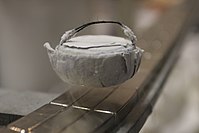
Photo from wikipedia
Superconductors have been being applied to a variety of large-scale power applications, including magnets, electric machines, and fault current limiters, because they can enable a compact, lightweight and high efficiency… Click to show full abstract
Superconductors have been being applied to a variety of large-scale power applications, including magnets, electric machines, and fault current limiters, because they can enable a compact, lightweight and high efficiency design. In applications such as those mentioned above, superconducting coils are always a key component. For example, in a superconducting electric machine, the superconducting coils are used to generate the main flux density in the air gap, which is significantly important for the energy conversion. It is the performance of the superconducting coils that plays an essential role in determining the performance of the device. However, the performance of a superconducting coil is limited by its critical current, which is determined by temperature and the magnitude and orientation of the magnetic field inside the superconductors. Hence, in-depth investigations to estimate the critical current of the superconducting coils are necessary before manufacturing. Available transient simulation models to estimate the critical current are through the H- and T-A formulations of Maxwell's equations. Both methods consider the same current ramp-up process occurring in experiments. Besides these transient models, static simulations can also be used: a modified load-line method and the so-called P-model, which is based on the asymptotic limit of Faraday's equation when time approaches infinity. To find the best way to calculate the critical current, the four methods are used to estimate the critical current of a double pancake superconducting coils and results are compared with experiments. As a conclusion, T-A formulation, P-model, and the modified load-line methods are recommended for estimating the critical current of the superconducting coils.
Journal Title: Superconductor Science and Technology
Year Published: 2018
Link to full text (if available)
Share on Social Media: Sign Up to like & get
recommendations!